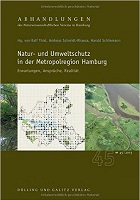Nature conservation and environmental protection in the Hamburg metropolitan region

Nature and Environmental Protection in the Hamburg Metropolitan Region: Expectations, Demands and Reality. This is the title of the new book published by the Hamburg Natural Science Association. It bundles expert knowledge and provides a fact check: Does the "European Green Capital" live up to its title? What is the real state of environmental awareness in the metropolitan region?
In the fall of 2012, the Natural Science Association in Hamburg organized a highly acclaimed series of lectures on nature conservation and environmental protection in the Hamburg metropolitan region. Now the association has succeeded in securing the speakers of that time as authors of an anthology. They have all been involved in this important field for many years and have a proven track record. The result is a uniquely up-to-date, comprehensive, generally understandable and competent fact check, which will be published on October 19, 2015.
Four years ago, Hamburg was awarded the title "European Green Capital".
The jury of the European Commission justified the award by saying that Hamburg had made great achievements in the years before and achieved excellent environmental standards. Ambitious plans for the future promised further improvements. The positive assessment of Hamburg's environmental efforts did not go unchallenged. At
On the contrary, there was fierce and varied criticism.
In the meantime, positive initiatives are definitely discernible, supported by Hamburg authorities, companies and nature conservation associations. For example, BUND Hamburg, NABU Hamburg and Aktion Fischotterschutz have been working together to promote the near-natural development of the Alster and its tributaries in the "Living Alster" project, which has been running since summer 2011. As part of the Hamburg Port Authority's "Kreetsand" pilot project, a near-natural, tide-influenced shallow water area of around 30 hectares has been under construction on the Norderelbe since 2012. Furthermore, the "Elbe Sediment Pollution Remediation (ELSA)" project, which is supported by the Hamburg Ministry for Urban Development and the Environment and has been running in its second phase since the beginning of 2015, aims to promote measures to improve the pollutant situation of the Elbe and, in particular, the Elbe sediments.
However, there are still problem areas. For example, the European Commission is currently suing the Federal Republic of Germany for not having sufficiently observed the provisions of the Flora-Fauna-Habitat Directive when approving the coal-fired power plant in Hamburg-Moorburg. Protected species such as salmon, river lamprey and sea lamprey could be in danger.
Now, one certainly cannot judge the quality of nature conservation and environmental protection in the entire metropolitan region on the basis of individual events, however significant they may be. With the volume of papers now presented, the Natural Science Association therefore offers the possibility of obtaining more comprehensive information on fundamental questions of nature and environmental protection in and around Hamburg.
Nature and Environmental Protection in the Hamburg Metropolitan Region: Expectations, Demands and Reality is the 45th volume of the Abhandlungen of the Naturwissenschaftlicher Verein in Hamburg. It will be published on October 19.
2015 by Dölling und Galitz Verlag. Upon request, we will be happy to send you a review copy of the book. In return, we would be pleased to receive a copy of your review.
The authors and their topics:
- Dr. Reinmar Grimm, Privatdozent für Zoologie, Ökologie und Naturschutz at the University of Hamburg, gives a well-founded overview of the discussion of nature and environmental protection in Hamburg since 1994. And he shows that it might be difficult for Hamburg to maintain its image of the "Green City" in the long term.
- Dr. Hans-Helmut Poppendieck, until 2013 curator at the Herbarium Hamburgense of the University of Hamburg, describes the plant biodiversity in Hamburg, which is the basis for the image of the "Green City". For his knowledgeable contribution, he evaluated some 800,000 data records on the distribution, frequency and endangerment of Hamburg's flora.
- Prof. Dr. Günter Miehlich, who taught at the Institute of Soil Science at the University of Hamburg, showed in an exciting contribution how important the city's soils, some of which are very diverse, are for biodiversity in nature reserves. They influence higher plants and animals and are habitats for soil organisms. Miehlich also makes concrete suggestions for future soil protection in Hamburg.
- Bernd-Ulrich Netz, head of the nature conservation department of the Hamburg Authority for Urban Development and the Environment, turns his attention to the Elbe estuary and comments on future management plans for this landscape, which plays a particularly important role in nature conservation in the region.
- Prof. Dr. Kai Jensen, Head of the Department of Applied Plant Ecology at the University of Hamburg, and geographer Wiebke Schoenberg, Middle and Lower Elbe Desk Officer at WWF Germany, also look to the future. They describe possible effects of climate change on ecosystems in the Hamburg metropolitan region and point out challenges that nature conservation must face in times of climate change.
- Alexander Porschke, former environmental senator and chairman of NABU Hamburg, Christian Gerbich, head of NABU's "Kingfisher" project, and Katharina Schmidt, responsible at NABU for Hamburg's nature outside protected areas, conclude the book with an explosive outline of a future nature conservation policy in Hamburg that actually delivers what the word promises. Among other things, they make it unmistakably clear that although Hamburg's nature has a lot to offer, it is only likely to remain so in the long term if politicians take effective decisions - for example, on planning and financing the particularly important maintenance and development of nature reserves.
Book information:
Nature and Environmental Protection in the Hamburg Metropolitan Region:
Expectations, demands and reality
(Papers of the Natural Science Association in Hamburg)
(2016)
Verlag: Dölling u. Galitz
ISBN: 978-3-8621-8081-3, 168 pages

